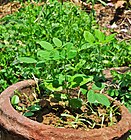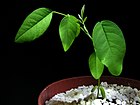Note: This is a project under development. The articles on this wiki are just being initiated and broadly incomplete. You can Help creating new pages.
Clitoria ternatea - Aparajita
Clitoria ternatea is commonly known as Asian pigeonwings, bluebellvine, blue pea, butterfly pea, cordofan pea and Darwin pea, is a plant species belonging to the Fabaceae family. The flowers of this vine have the shape of human female genitals, hence the Latin name of the genus "Clitoria", from "clitoris".
Uses
Blisters in mouths, mouth sores, bleeding piles, leucorrhoea, Mild diabetes, Cough, physical weakness, ulcer, Urinary trouble, snakebite, infection in intestine.
Parts Used
Chemical Composition
Major flavonol glycosides, 3-O-(2"-O-alpha-rhamnosyl-6"-O-malonyl)-beta-glucoside, 3-O-(6"-O-alpha-rhamnosyl-6"-O-malonyl)-beta-glucoside and 3-O-(2",6"-di-O-alpha-rhamnosyl)-beta-glucoside of kaemferol, quercetin and myricetin were isolated from the petals[1]
Common names
| Language | Common name |
|---|---|
| Kannada | Aparajite, Girikarnike |
| Hindi | Khagin |
| Malayalam | Sangu Pushpam |
| Tamil | Sankupushpam, Kakkanam |
| Telugu | Sankhu-pushpamu |
| Marathi | NA |
| Gujarathi | NA |
| Punjabi | NA |
| Kashmiri | NA |
| Sanskrit | Ghrstih, Aparajita, Radha, Adrikarni |
| English | Clitoria, Butterfly Bean |
Habit
Identification
Leaf
| Kind | Shape | Feature |
|---|---|---|
| Imparipinnate | Ovate | Leaf Arrangement is Alternate distichous, Leaf Apex is Obtuse, Leaf Base is Obtuse and Leaf Margin is Entire |
.[2]
Flower
| Type | Size | Color and composition | Stamen | More information |
|---|---|---|---|---|
| Solitary | 2-4cm long | deep blue, occasionally white | 8-10 | Flowering from March-May |
Fruit
| Type | Size | Mass | Appearance | Seeds | More information |
|---|---|---|---|---|---|
| oblong pod | Fruit is linear | seeds 10-15 | Fruiting throughout the year | {{{6}}} |
Other features
List of Ayurvedic medicine in which the herb is used
- Vishatinduka Taila as root juice extract
Where to get the saplings
Mode of Propagation
How to plant/cultivate
The more common species of Aconitum are generally those cultivated in gardens, especially hybrids. They typically thrive in well-drained evenly moist garden soils like the related hellebores and delphiniums, and can grow in the shade of trees.
Commonly seen growing in areas
Photo Gallery
References
External Links
- Pages that are stubs
- Ayurvedic Herbs known to be helpful to treat Blisters in mouths
- Ayurvedic Herbs known to be helpful to treat mouth sores
- Ayurvedic Herbs known to be helpful to treat bleeding piles
- Ayurvedic Herbs known to be helpful to treat leucorrhoea
- Ayurvedic Herbs known to be helpful to treat Mild diabetes
- Ayurvedic Herbs known to be helpful to treat Cough
- Ayurvedic Herbs known to be helpful to treat physical weakness
- Ayurvedic Herbs known to be helpful to treat ulcer
- Ayurvedic Herbs known to be helpful to treat Urinary trouble
- Ayurvedic Herbs known to be helpful to treat snakebite
- Ayurvedic Herbs known to be helpful to treat infection in intestine
- Herbs with seeds used in medicine
- Herbs with leaves used in medicine
- Herbs with Root used in medicine
- Herbs with common name in Kannada
- Herbs with common name in Hindi
- Herbs with common name in Malayalam
- Herbs with common name in Tamil
- Herbs with common name in Telugu
- Herbs with common name in Sanskrit
- Herbs with common name in English
- Habit - A small wiry straggler(5m)
- Index of Plants which can be propagated by Seeds
- Herbs that are commonly seen in the region of tropical
- Herbs that are commonly seen in the region of Caribbean Islands
- Herbs that are commonly seen in the region of subtropical
- Herbs that are commonly seen in the region of pinelands
- Herbs that are commonly seen in the region of hammocks
- Herbs









